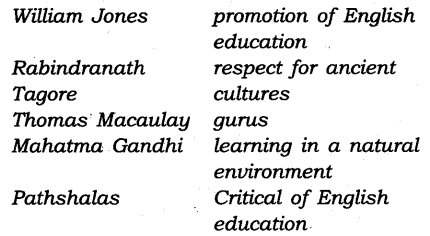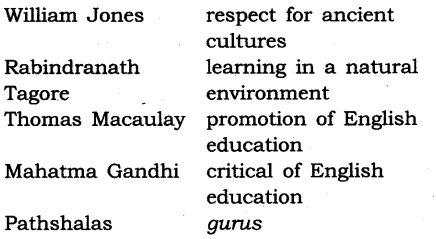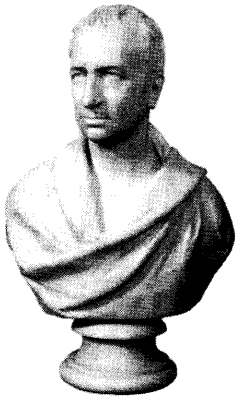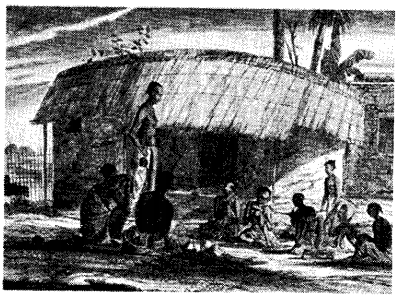NCERT Solutions for Class 8 Social Science History Chapter 8 Civilising the “Native”, Educating the Nation
NCERT Solutions for Class 8 Social Science History Chapter 8 Civilising the “Native”, Educating the Nation
NCERT Solutions for Class 8 Social Science History Chapter 8 Civilising the “Native”, Educating the Nation
Question 1.
Match the following:

Answer:

Question 2.
State whether true or false
- James Mill was a severe critic of the Orientalists.
- The 1854 Despatch on education was in favour of English being introduced as a medium of higher education in India.
- Mahatma Gandhi thought that the promotion of literacy was the most important aim of education.
- Rabindranath Tagore felt that children ought to be subjected to strict discipline.
Answer:
- True
- True
- False
- False
Question 3.
Why did William Jones feel the need to study Indian history, philosophy and law?
Answer:
- William Jones came to represent a particular attitude towards India. He shared a deep respect for ancient cultures, both of India and of the West.
- Jones and Colebrooke felt that India had attained its glory in the ancient past. It declined later on. In order to understand India, it was necessary to discover the sacred and legal texts produced in the past.
- These texts would reveal the ideas and laws of Hindus and Muslims and would form the basis of future development.
- Jones and Colebrooke believed that their project would help the British learn from Indian culture. Indians would also rediscover their own heritage. In this way the British would become guardians and masters of Indian culture.
Question 4.
Why did James Mill and Thomas Macaulay think that European education was essential in India?
Answer:
- James Mill was the strongest critic of the Orientalists.
- He declared that the British should not teach what the natives wanted, or what they respected, in order to please them and “win a place in their heart”.
- The £pm of education should be to teach what was useful and practical.
- Indians should be made familiar with the scientific and technical advances that the West had made, and not the sacred literature of the Orient.
- Macaulay urged the British government in India to stop wasting public money in promoting Oriental learning, for it had no practical use.
- He felt that knowledge of English would allow Indians to read some of the finest literature the world had produced; it would make them aware of the developments in Western science and philosophy.
- The teaching of English could thus be a way of civilizing people, changing their tastes, values, and culture.
Question 5.
Why did Mahatma Gandhi want to teach children handicrafts?
Answer:
Mahatma Gandhi wanted to teach children handicraft because of the following reasons:
- People would work with their hands.
- The craft would develop their minds.
- It would also develop their capacities to understand.
Question 6.
Why did Mahatma Gandhi think that English education had enslaved Indians?
Answer:
-
According to Mahatma Gandhi, colonial education created a sense of inferiority in the minds of Indians. He said it made them see Western civilisation as superior which destroyed the pride they had in their own culture.
He said: It was sinful—it enslaved Indians—it cast an evil spell on them. - Charmed by the West, appreciating everything that came from the West, Indians educated in these institutions admired British rule.
- Mahatma Gandhi wanted an education that could help Indians recover their sense of dignity and self-respect.
- Mahatma Gandhi -strongly was in favour of Indian languages to be the medium of teaching.
- Education in English crippled Indians and distanced them from their own social surroundings. This made them “straneers in their own lands”. Speaking a foreign tongue (language) despised local culture.
-
Mahatma Gandhi further said that western education focused on reading and writing rather than oral knowledge;
- It valued textbooks rather than life experience and practical knowledge.
- He said education should develop a person’s mind and soul.
- Literacy or simply learning to read and write—by itself did not count as education.
- People had to work with their hands and learn a craft. They should know how different things operated.
Question 7.
Find out from your grandparents about what they studied in school.
Answer:
- Urdu/Hindi language
- Mathematics
- Social study, Drawing.
Question 8.
Find out about the history of your school or any other school in the area you live.
Answer:
I study in St. Peters Acadamy. It is the oldest one in this region. It was established by a Christian Missionary in 1980. It has created many histories by achieving so many events to its credit. The Principal is always appointed by the missionary. The man of high academic repute and administrative quality is appointed here as Principal. Teachers are also of high talent. There are five thousand students. Its students always bring high laurels to school and region by achieving bright result in Board Examinations. I am proud of my school.
Class 8 History Chapter 8 Civilising the “Native”, Educating the Nation Exercise Questions
Question 1.
Choose the correct option.
(i) The ideas of William Jones were supported by
(a) James Mill
(b) Thomas Macaulay
(c) Charles Wood
(d) Henry Thomas Colebrooke
(ii) A madrasa was set up in Calcutta in 1781 to promote the study of
(a) Urdu
(b) Arabic
(c) Ancient history of India
(d) Muslim religion
(iii) Who attacked the Orientalists?
( a) James Mill
(b) Thomas Macaulay
(c) Both (a) to (b)
(d) None of the above
(iv) The name associated with the establishment of Serampore Mission
(a) Thomas Macaulay
(b) Henry Thomas Colebrooke
(c) William Carey
(d) William Jones
(v) William Adam toured the districts of
(a) Bihar and Orissa
(b) Bihar and Bengal
(c) Bengal and Rajasthan
(d) Orissa and Madhya Pradesh
Answer:
(i) (d), (ii) (b), (iii) (c), (iv) (c), (v) (b).
Question 2.
Fill in the blanks with appropriate words to complete each sentence.
- Warren Hastings took the initiative to set up the Calcutta ………… and believed that ancient customs of the country and ……………..of learning ought to be the basis of ………… rule in India.
- Thomas Macaulay saw India as an …………… country that needed to be.
- Together with Henry Thomas Colebrooke and Nathaniel Halhed, Jones set up the ……………. of Bengal, and started a journal called …………………
- Many British officials said that knowledge of the was full of errors and thought …………….
- There was no system of annual examinations in …………..
- Rabindranath Tagore started …………… in 1901.
Answer:
- Madrasa, customs, oriental
- uncivilised, civilised
- Asiatic Society, Asiaticle Researches
- East, unscientific
- Pathshalas
- Shantiniketan
Question 3.
State whether each of the following statements is True or False.
- Wood’s Despatch emphasised the practical benefits of a system of European learning.
- Mahatma Gandhi never approved English education in India.
- Rabindranath Tagore did a lot for the spread of English education in India.
- Pathshalas followed strict rules and regulations.
- Thomas Macaulay was in favour of the promotion of Oriental institutions.
- James Mills was a Scottish missionary who toured the districts of Bengal and Bihar.
- Tagore set up his school, Le. Shantirdketan in a rural setting.
Answer:
- True
- True
- False
- False
- False
- False
- True.
Question 4.
Match the hems given in Column A correctly with those given in Column B.

Answer:
(i) (c), (ii) (a), (iii) (e), (iv) (b), (v) (d).
Class 8 History Chapter 8 Civilising the “Native”, Educating the Nation Very Short Answer Type Questions
Question 1.
Name the different languages that William Jones studied.
Answer:
Greek, Latin, English, French, Arabic and Persian.
Question 2.
Why was Calcutta Madrasa set up?
Answer:
Calcutta Madrasa was set up to promote the study of Arabic, Persian and Islamic law.
Question 3.
Why was the Hindu College established in Benaras?
Answer:
The Hindu College was established in Benaras to encourage the study of ancient Sanskrit texts that would be useful for the. administration of the country.
Question 4.
Name two individuals who sharply attacked the Orientalists.
Answer:
James Mill and Thomas Babington Macaulay.
Question 5.
What did Thomas Macaulay urge the British government in India?
Answer:
Thomas Macaulay urged the British government in India to stop wasting public money in promoting Oriental learning for it was of no practical use.
Question 6.
How were Oriental institutions like the Calcutta Madrasa and Benaras Sanskrit College viewed by the British?
Answer:
These Oriental institutions were viewed as temples of darkness that were falling of themselves into decay.
Question 7.
Name the places where the British established universities.
Answer:
Calcutta, Madras and Bombay.
Question 8.
Where were classes held under the system of pathshalas?
Answer:
Classes were held under a banyan tree or in the comer of a village shop or temple or at the guru’s home.
Question 9.
What type of education was given to the children in pathshalas?
Answer:
Children were given oral education in pathshalas.
Question 10.
Why were classes not held during harvest time?
Answer:
It was because rural children had to work in the fields during harvest time.
Question 11 .
What task was assigned to the pandit by the Company?
Answer:
The Company assigned the pandit to visit the pathshalas and try to improve the standard of teaching.
Question 12 .
Name two Indians who reacted against Western education.
Answer:
Mahatma Gandhi and Rabindranath Tagore.
Question 13 .
What do you mean by Tagore’s abode of peace?
Answer:
Tagore’s Shantmiketan was established in a rural setting, 100 kilometres away from Calcutta. As it was far from the din and bustle of the city it was an abode of peace.
Question 14.
How did Tagore view his school namely Shantmiketan?
Answer:
He viewed his school as an abode of peace where living in harmony with nature, children would cultivate their natural creativity.
Class 8 History Chapter 8 Civilising the “Native”, Educating the Nation Short Answer Type Questions
Question 1.
Why did many Company officials in India want to promote Indian rather than Western learning?
Answer:
Many Company officials felt that institutions should be set up to encourage the study of ancient Indian texts and teach Sanskrit and Persian literature and poetry. These officials were of the opinion that Hindus and Muslims ought to be taught what they were already familiar with and what they valued and preserved, not subjects that were alien to them. They believed that only by doing this the British could win the hearts of the Indians, only then they could expect to be respected by their subjects.
Question 2.
What were the views of other Company officials?
Answer:
Other Company officials did not approve the ideas of the Orientalists. They began to criticise the Orientalist- vision of learning. They saved that the knowledge of the East was full of errors and unscientific thought. They saw Eastern literature as non-serious and light-hearted. So, they argued that it was wrong on the part of the British to spend so much effort in encouraging the study of Arabic and Sanskrit language and literature.
Question 3.
Define the term ‘vernacular’. Why did the British use this term in colonial countries like India?
Answer:
The term Vernacular’ refers to a local language or dialect as distinct from what is known as the standard language.
In colonial countries like India, the British used this term to mark the difference between the local languages of everyday use and English, the language of the imperial masters.
Question 4.
What measures were taken by the English Education Act of 1835?
Answer:
The following measures were taken under the English Education Act 1835:
- English was made the medium of instruction for higher education.
- Promotion of Oriental institutiohs like the Calcutta Madrasa and Benaras Sanskrit College was stopped. These institutions were seen as temples of darkness that were falling of themselves into decay.
- English textbooks began to be produced for schools.
Question 5.
What measures were taken by the British after issuing of Wood’s Despatch?
Answer:
Following measures were taken:
- Education departments of the government were set up to extend control over all matters regarding education.
- A system of universities education was introduced. Universities were established in Calcutta, Madras and Bombay.
- Attempts were also made to bring about changes within the system of school education.
Question 6.
How were the views of Tagore and Mahatma Gandhi on the West different?
Answer:
Both Tagore and Mahatma Gandhi thought about education in similar ways. But there were differences too. Gandhiji was highly critical of Western civilisation and its worship of machines and technology. Tagore wanted to combine elements of modem Western civilisation with what he saw as the best within Indian tradition. He emphasised the need to teach science and technology at Shantiniketan, alongwith art, music and dance.
Class 8 History Chapter 8 Civilising the “Native”, Educating the Nation Long Answer Type Questions
Question 1.
What was Wood’s Despatch? What were its provisions?
Answer:
The Court of Directors of the East India Company in London sent an educational despatch to the Governor- General in India in the year 1854. As the despatch was issued by Charles Wood, the President of the Board of Control of the Company, it came to be known as Wood’s Despatch. ‘ Wood’s Despatch outlined the educational policy that was to be followed in India. It criticised the Oriental knowledge and emphasised the need of European learning. The Despatch made it clear that European learning would enable Indians to recognise the benefits that would flow from the expansion of trade and commerce. It would also make them see the importance of developing country’s resources. Indians needed to adopt European ways of life because this would change their tastes and desires and create a demand for British goods.
Wood’s Despatch further argued that European learning would improve the moral character of the people of India. It would make them honest and raliable and thus supply trusted civil servants to the Company.
The Despatch strongly criticised the literature of the East because it was full of errors and unable to instill in people a sense of duty and a commitment to work.
Question 2.
What measures were undertaken by the Company to improve the system of vernacular education?
Or
How were the irregularities ofpathshalas checked by the Company?
Answer:
There were no rules and regulations in pathshalas. Hence, the Company decided to improve the entire system. It took several measures:
- It appointed a number of government pandits, each in charge of looking after four to five schools. The task of the pandit was to vi§it the pathshalas and try and improve the standard of teaching.
- Each guru was asked to submit periodic reports and take classes according to a regular time table.
- Teaching was now to be based on textbooks and learning was to be tested through a system of annual examination.
- Students were asked to pay a regular fee, attend regular classes, sit on fixed seats, and obey the new rules of discipline.
Question 3.
What type of education did Mahatma Gandhi want in India?
Answer:
Mahatma Gandhi never approved English education because it had created a feeling of inferiority in the minds of millions of Indians. In fact he wanted an education that could help the people of India restore their sense of dignity and self-respect. During the time of the national movement he urged students to leave educational institutions to show the British that they could no longer enslave Indians.
Mahatma Gandhi never wanlfttf English to be the medium of teaching. Instead he thought that students ought to be taught in the medium of Indian languages. Education in English crippled the people of India. It distanced them from their own surroundings. It made them alien in their own lands. Hence, he felt that English education ought not to flourish in India any more. He urged that education ought to develop a person’s mind and soul. Simply learning to read and write did not matter at all. People had to learn a craft and know how different things operated. This would definitely develop their mind and their capacity to understand.
Question 4.
Write a note on Rabindranath Tagore and his school Shantiniketan.
Answer:
Rabindranath Tagore, like Mahatma Gandhi, also did not approve Western education wholeheartedly. At the time when several Indians urged the British to open more and more schools, colleges and universities in order to spread English education in India, Rabindranath Tagore reacted strongly against such education.
He was a great educationist But he hated going to school because he saw it oppressive. In fact he wanted . to establish a school where the children were happy and were free to explore their thoughts and desires without feeling any suppression. He advocated for giving children natural surroundings where they would be able to cultivate their natural creativity.
Keeping the above ideals in mind, Rabindranath Tagore established Shantiniketan in the year 1901. He regarded it as an ‘abode of peace’. He set up his school 100 kilometres away from Calcutta, in a rural setting in order to provide children a very peaceful environment. Here, they could develop their imagination and creativity. Tagore was of the opinion that existing schools were killing the natural desires of the children to be creative.
Hence, it was necessary to help them develop their curiosity by providing them good teachers who could understand them. By establishing an institution like Shantiniketan he did a great job in the field of education.
Class 8 History Chapter 8 Civilising the “Native”, Educating the Nation Source-Based Questions
Question 1.
Read the following extract (Sources 2 and 3) taken from NCERT textbook subsequently and answer the questions that follow:
1. An argument for European knowledge
Wood’s Despatch of 1854 marked the final triumph of those who opposed Oriental learning. It stated:
We must emphatically declare that the education which we desire to see extended in India is that which has for its object the diffusion of the improved arts, services, philosophy, and literature of Europe, in short, European knowledge.
Questions:
(i) When did Wood’s Despatch come in light?
(ii) What type of education did the Despatch want to extend in India?
Answers:
(i) Wood’s Despatch came in light in 1854.
(ii) The Despatch advocated for European learning, because it was the only way to make Indians perfect in all sense. It would introduce them the European ways of life and would change their tastes and desires.
Question 2.
“Literacy in itself is not education”
Mahatma Gandhi wrote:
By education I mean an all-round drawing out of the best in child and man—body, mind and spirit. Literacy is not the end of education nor even the beginning. It is only one of the means whereby man and woman can be educated. Literacy in itself is not education. I would therefore begin the child’s education by teaching it a useful handicraft and enabling it to produce from the moment it begins its training … I hold that the highest development of the mind and the soul is possible under such a system of . education. Only every handicraft has to be taught not merely mechanically as is done today but scientifically, i.e. the child should know the why and the wherefore of every process.
‘ The Collected Works of Mahatma Gandhi, Vol. 72, p. 79’
Questions:
(i) How does Mahatma Gandhi view literacy?
(ii) Why does he give so much emphasis on learning a useful handicraft?
Answers:
(i) According to Mahatma Gandhi literacy in itself is not education. It is not the end of education nor even the beginning. It is only one of the means whereby man and woman can get education. Hence, it should not be anyone’s goal.
(ii) He gives much emphasis on learning a useful handicraft because it enables the child to produce from the moment he Begins its training. It makes him aware of how different things are operated.
Class 8 History Chapter 8 Civilising the “Native”, Educating the Nation Picture-Based Questions
Question 1.
Observe the pictures taken from NCERT textbook and answer the questions that follow:

Questions:
(i) Who is he?
(ii) What do you know about him?
Answers:
(i) He is Heniy Thomas Colebrooke.
(ii) He was a great scholar of Sanskrit and ancient sacred writings of Hinduism.
Question 2.

Questions:
(i) What is it?
(ii) Write a brief note on the system of education that existed here.
Answers:
(i) It is a village pathshala.
(ii) The system of education that existed here was flexible. There were no rules and regulations. There were no roll-call registers, no annual examinations and no regular time-table. Students were given oral teaching. They were taught in accordance with their needs.
More CBSE Class 8 Study Material
- Maths NCERT Solutions Class 8
- Science NCERT Solutions Class 8
- CBSE Class 8 Social Science Questions and Answers
- English NCERT Solutions Class 8
- NCERT Solutions for Class 8 English Honeydew
- NCERT Solutions for Class 8 English It So Happened
- Hindi NCERT Solutions Class 8
- Sanskrit Ruchira Class 8 Guide Download
- NCERT Solutions